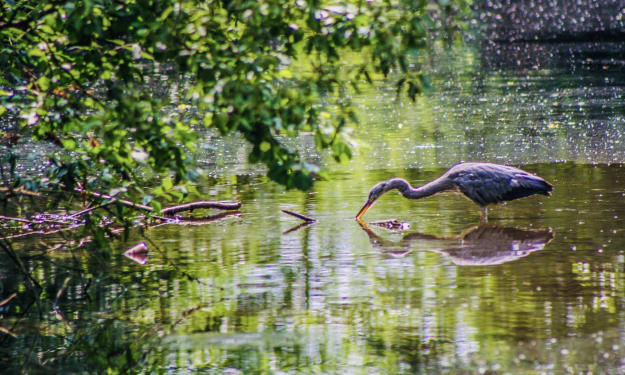10 Ways to Get Out of Your Photography Rut
And learn new ways to shoot

Photographers get stuck in ruts like everyone else. Whether it’s food, landscapes, or portraiture, you shoot the same thing the same way every time you head out with the camera. If you want to refresh your photography style, this article gives you ten ways to get out of your photography rut.
Start a pet project
Browse through photographer’s posts on social media, and you will find many examples of personal projects. One is a picture a day for a year. Commit to a project like this and stick with it. Even if you don’t make it through a year, it will force you to get out and decide what and where to shoot. You will get a photo in places you’ve never shot, like in your office or at the store.
Another type of pet project is to chronicle passing time in your photography. Choose a location, such as a construction site, and shoot it weekly or anytime there is a major change to the scene. You could combine these two ideas by finding a location, preferably in nature, and shooting it from the same location every day. Observing the changes, not just in seasons, but in light and other more subtle ways will hone your skills in seeing what you shoot
Use different equipment
This doesn’t mean change your lens, although I will cover that idea shortly. You need a more radical change to jump-start your creativity. Buy an old film camera and shoot with that. Knowing you don’t have post-processing to fall back on will make you really consider your next shot. On the opposite end of the spectrum, go out with your cellphone. Being forced to figure out the shot without all the fancy gear will change how you approach your photography.
You need not change your camera to use this tip, add or change some of your peripheral equipment. If you never use flash, put one on and leave it there for a while. Pondering how to nail the shot while firing a flash, even outdoors, will change up how you perceive the light on a scene and how to change it. Try using fill flash in all your outdoor shots, or shoot portraits indoors without casting harsh shadows can alter your perception of the quality and directionality of the light.
Shoot in new ways
Changing how and where you shoot can make an enormous difference in your photography. If you always shoot in the studio, head outdoors. Landscape photography requires a different mindset. You will think about depth-of-field in an alternative way. Now you are trying to get miles of distance in focus instead of inches. Your light source will only be the sun, and time of day becomes crucial to nailing the shot.
If you never shoot in a studio, take your photography inside. Using strobes to light your subject creates a whole extra set of challenges. Better yet, stick with natural light. Figuring out how to light a scene with only window light and reflectors will give you a fresh perspective on using and shaping the light.
Get close
Getting close may mean using a macro lens. If you don’t have one, check the minimum focal length on all your lenses, and use the shortest one. Shooting very close to a subject will change how you think about depth-of-field and selective focus. This can be a huge change for a landscape photographer. Instead of getting a nearby barn and distant mountains in focus, you are hoping for another eighth of an inch.
Getting close doesn’t have to mean macro photography. Whatever the subject, move in closer than normal. This will give a unique perspective and make you think about the subject. If you are photographing a person, move close, so you fill the entire frame with their face or even part of the face. If you shoot architecture, move in tight and capture a detail, such as a doorknob or a cornerstone. Shoot details of a subject so close that your audience may wonder about what it is.
Stay out late or get up early
Most everyone adopts a pattern of sleep and wakefulness that doesn’t change from day-to-day. As a photographer, you should change this, anyway. You take the best landscape shots just after sunrise and just before sunset, so you alter your schedule, anyway. But try changing it even more. Go before sunrise or after sunset for night photography. You will need a tripod for this one, and it will challenge how you think about exposure and shutter speed.
If you live in or have access to the countryside, try astrophotography. Pointing the camera up and trying to capture the stars and moon is a unique challenge. Finding the proper exposure is harder than you think. Also, shutter speed can be problematic. Planets and stars are moving more than you think they are. Stuck in the city? No problem. Shooting cityscapes, street and car lights, neon signs, and reflections will give you a myriad of subjects at night.
Emulate another photographer’s style
This doesn’t mean you steal someone else’s work. But trying to deconstruct and reverse engineer someone else’s photography can give you a unique perspective and change how you shoot. Think about it. This emulation is how Rembrandt lighting became so popular in portraiture. Someone looked at paintings of the old master and emulated that with a modern camera. Study a portrait you admire and then try to recreate it in your own studio.
But this tip isn’t about studio lighting. Get outside and try to recreate the images of your favorite landscape photographer. You don’t have to travel to Yellowstone Park to imitate Ansel Adams. Study an image and figure out how they shot it. What time was it taken and with what shutter speed? Were there any specialized tricks used, such as HDR or focus stacking? How did they get those rich colors and vivid saturation? Thinking through these factors will make you consider your day-to-day shooting.
Shoot with one prime lens
Shooting with one lens is one of the best ways to change up how you shoot and get out of your photography rut. And you can’t use a zoom for this experiment. That would be cheating. Put a single focal length prime lens on your camera and leave it there for a week, or even a month. If you don’t have a prime, get one. The 50mm f1.8 lens, or nifty-fifty, as it’s called, is a very good lens and affordable. But the focal length you use doesn’t matter as long as it never changes.
Using a single focal length will change how you think about your shots. It will force you to “zoom with your feet,” moving closer or further away from the subject to achieve the framing you desire. It will force you to give more thought to composition, depth-of-field, background, compression, and all the other subtle factors you may have taken for granted using a zoom lens. Cameras used to come with a single prime lens, frequently a 50mm, and many photographers shot for years with that lens. Step back in time and into their shoes and give your images a fresh perspective.
Change perspective
Speaking of perspective, change yours. One trap many photographers fall into is always shooting from the same perspective. They always shoot from eye level and take the shot as soon as they see the subject. Spend more time looking at the subject and changing your perspective. Get down low. Shooting up at a subject will give you a unique image. Get up high. If you are shooting a person, get on a step stool or ladder, and have them look up at you. Whether child or adult, it will give them a distinct view than shooting them at eye level.
But don’t restrict the perspective to height. Move around the subject. Look at it and shoot it from every angle. Moving around a subject will force you to consider, not just the subject, but the background as it is changing. From this, you will learn to consider the background of your subjects, which is essential for good composition.
Work with strangers
One phrase you will often hear when looking into any change is, “Get Out of Your Comfort Zone.” And nothing will force people out of their comfort zone quicker than dealing with complete strangers on the street. If you are a portrait photographer, this may not be a challenge, but you deal with people who approached you, not the other way around. Taking images of strangers on the street presents you with challenges, but can be a rewarding experience.
Working with strangers doesn’t mean sniping them from across the street with your long lens, but working with them. As you walk around your town, search for interesting people and stop them on the street. As uncomfortable as you are, consider them and put them at ease. Don’t just say, “Hey, can I take your picture?” Introduce yourself and tell them what you are trying to do. If you are uncomfortable, tell them you are taking a class on street photography, and this is a homework assignment. You will get rejections but will find people are open to helping you out and will get a novel experience to work into your photography style.
Change location
You have already tried going inside if you are a landscape photographer or outside if you shoot portraits, but now you need to change location more. If you live in a city, head out into the country or vice versa. Once again, get out of your comfort zone and put yourself into an unaccustomed environment. Wandering around a new situation will change how you speculate about the shot and composition in ways you may not have before.
But you don’t have to travel to put yourself in an unfamiliar shooting environment. If you live out in the country, head down that proverbial road less traveled. Go someplace you haven’t been and find an interesting subject. If you live in a town, drive to the next one and shoot it as if you were documenting the place. Or here’s a fresh idea. Everyone takes their city for granted. You’ve probably rarely visited most of the local tourist destinations. Pretend you just got into town and photograph it like someone on vacation.
Shooting the same subject year in and year out can make you very good at the style of photography you have chosen. But it can also make you complacent, lazy, and even boring. Make a date to try these tips to get out of your photography rut. Relearn what got you excited about photography to begin with. Not only will it give you different images for your portfolio, but it will also force you to rethink the things you shoot every day.
If you enjoyed this article, please click the Heart, and if you really liked it, consider dropping me a tip below. Thanks for reading.
About the Creator
Darryl Brooks
I am a writer with over 16 years of experience and hundreds of articles. I write about photography, productivity, life skills, money management and much more.






Comments
There are no comments for this story
Be the first to respond and start the conversation.